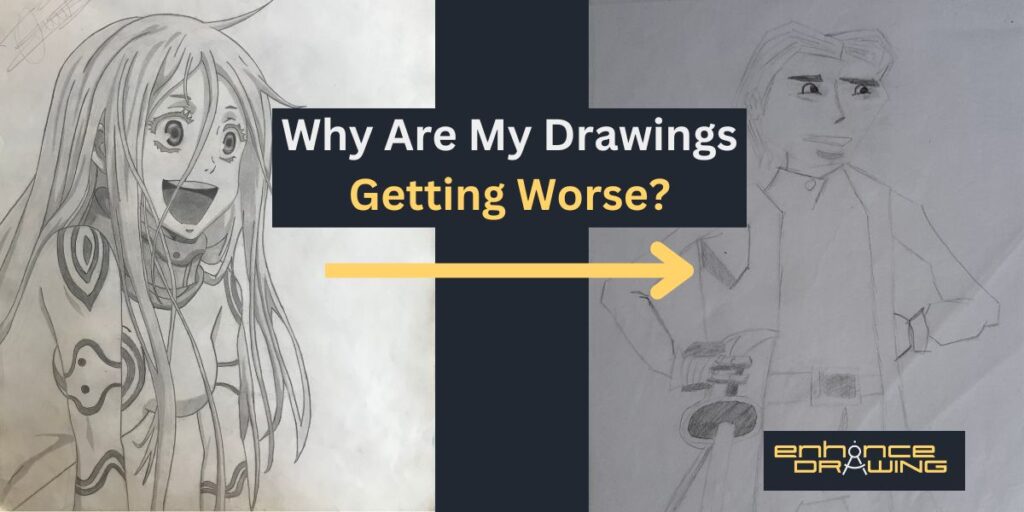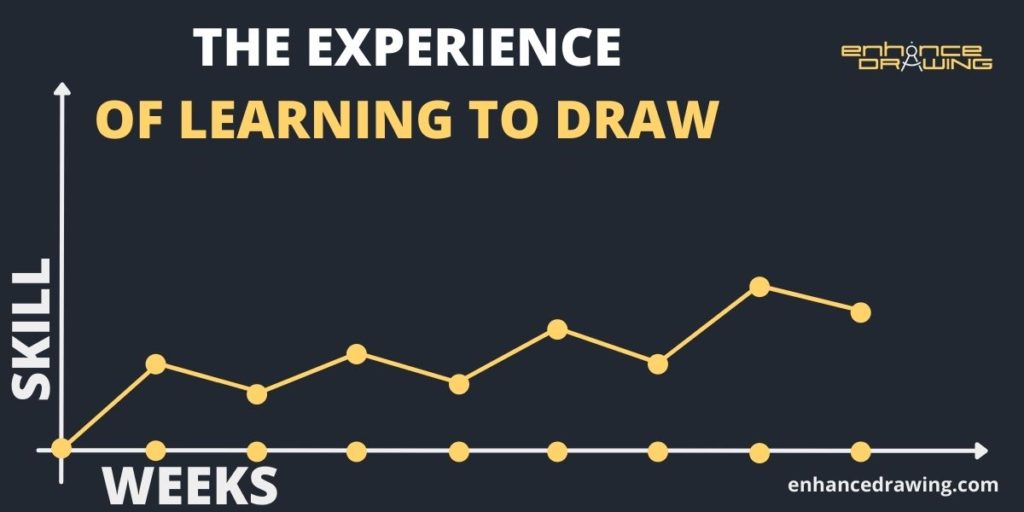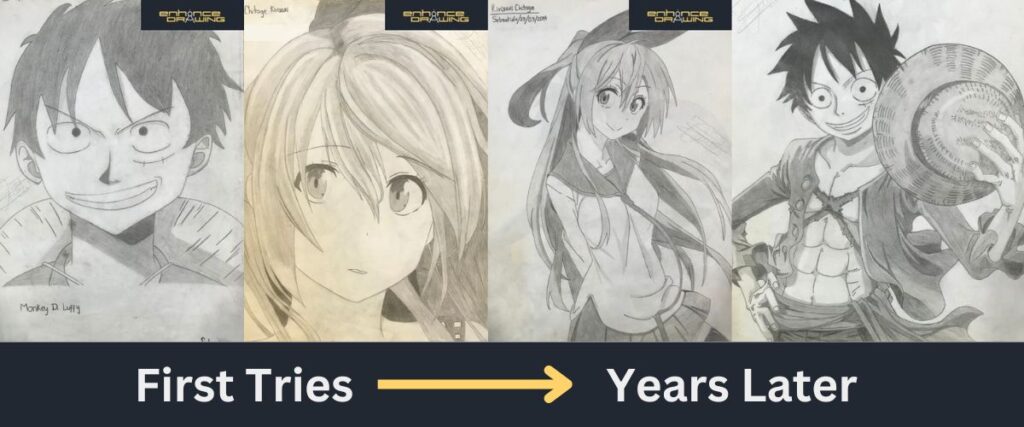
I totally understand that sinking feeling when you’ve poured so much time and effort into your drawing skills, and it seems like you’re actually regressing. Trust me, I’ve been there too, and it’s tough to stay confident and motivated in those moments.
But let me share something with you: I’ve been drawing for years, and just when I thought I was stuck in a rut, I stumbled upon five game-changing concepts that completely transformed my approach to drawing, and I can’t wait to pass them on to you!
So, if you’re feeling like your drawings are going downhill, don’t worry – I’ve got some great tips to help you out!
1- Your Eyes Are Better At Drawing Than Your Hands

There is a concept in the artistic community called the “critical eye,” and it refers to the ability of an artist to identify both the strengths and weaknesses of a drawing, such as proportions, perspective, shading, line quality, and overall composition.
The primary reason artists feel like they’re getting worse at drawing is their increasing ability to critique their own work as they mature. As they develop a sharper eye for detail, it becomes easier to spot errors and, consequently, to feel their drawings are getting worse.
This makes complete sense; everything we see in the world has accurate proportions and perfect perspective, so we get used to that over time, and whenever we see something a little off, our brain picks it up immediately. And then, suddenly, we start seeing that our drawings are full of flaws. (In my opinion, this is a great thing; it means there is room to grow.)
So, How Do You Stop Getting Worse At Drawing?
You need to strengthen the connection between your eyes and your hands. Gladly, there is a fantastic exercise that will help you achieve that in no time: drawing upside down. I have a blog explaining everything about drawing upside down and how to do the exercise step by step. It will teach you to focus on the lines that construct a drawing instead of the things your brain “assumes” it should look like.
The exercise will teach you how to draw anything accurately and, most importantly, show you that you can do it.
And what should you do about the flaws (opportunities) you encounter?
Your critical eye is not a curse but a blessing. And if you use it correctly, it will do wonders for your artistic improvement. Instead of thinking my art looks terrible, focus on what aspect you don’t like about it, practice it, and correct it. If there are multiple aspects, pick one and work on that one alone.
Frame your art under these three main categories (what most beginners will struggle to get right):
- Proportions: Judge whether the proportions of objects and figures in your drawing are correct and realistic.
- Perspective: Determine if the perspective in your drawing is accurate, ensuring that objects appear three-dimensional and follow the rules of linear perspective.
- Line Quality: Assess the precision and confidence of the lines you’ve used in your drawing.
If you think you need to improve in any of the categories above, take a look at your reference, measure, and try to figure out why you couldn’t get it right. If you can’t figure it out, it means you need to learn the fundamentals of proportions, perspective, or line quality -or whatever it is you’re trying to improve- and need to review it.
Tip: I know it will be frustrating to try to get it right multiple times and not be able to do it, but that’s what learning to draw is about. That’s what learning to do anything is about. Only take a step back once you feel you really tried enough times.
2- You’re Rushing When Comparing your Artwork

Acquiring any skill, especially drawing, will have ups and downs. Somehow, one day, you can draw something you couldn’t yesterday; the next, you can’t do it or even do it worse. Something in the learning process makes your brain learn things over weeks instead of days or hours.
You can experience this in multiple ways. Some days, you feel amazing energetic, and on others, you may feel slow and tired. And if you have ever played a sport, you should know there are good and bad days.
You know this, but for some reason, we artists overlook this common aspect of life and assume that if I was able to draw something yesterday, I must be able to draw it the same or best the day after, but never worse. Why? Learning to draw doesn’t work like that, and I made a graphic to show what learning to draw actually looks like.

This process will, of course, vary from person to person, but that is how it looks like for most people. Which brings me to the next thing, what to do about it?
So, Why Am I Bad At Drawing Sometimes?
You may feel like you’re bad at drawing sometimes because you are comparing your drawings to other drawings you did very recently, and that gives you inaccurate information.
By comparing a drawing you did today with one you did yesterday, you could find you are the next Michelangelo or a 2-year-old with a crayon. The information sample you’re using is too small, and real improvement will materialize after at least a week or even a month. Assuming you have been practicing daily or very regularly during that time.
So, the next time you feel like you’re getting worse at drawing, compare a recent drawing to one you did at least a month or two ago. Pick drawings that are similar to each other; don’t compare circles to squares.
Tip: Stop chasing after your previous drawings. I’ve been there, made something great, and then obsessed over replicating it for weeks. Analyzing is fun, but moving on and trying new things is key. In a few months, you’ll look back and wonder why you were obsessed with it, as you’ll have naturally progressed.
3- You’re Drawing Something You Haven’t Tried Before

Many people feel they are getting worse at drawing when they try to draw something they have never drawn before and fail. Even though we know what we are trying to draw is different, somehow, we convince ourselves that something else we drew right before was “harder,” which should mean we got worse.
See, learning to draw is like learning to write, and what the fundamentals would be for drawing, the letters, and grammar would be for writing. As you draw, unless you are drawing without structure -not recommended- you’re probably studying some aspect of drawing.
When you start studying a new aspect of drawing that you haven’t tried before, you will likely fail a couple of times until you get it right. That’s learning, and it doesn’t mean you’re getting worse at drawing. So, let’s say you start studying the figure and constructing the human body, and somehow, all your drawings look stiff and weird; you start thinking: How can I not draw this with all my experience? Well, simply because it’s new to you.
So, why am I suddenly struggling to draw?
You will suddenly struggle to draw whenever you draw something out of your comfort zone. Acquiring new skills will always be a challenge, so instead of beating yourself up and saying that you’re getting worse at drawing, you should instead say that you’re learning a new drawing technique. Again, if you want to measure progress, compare your drawings between at least a month and not from what you drew yesterday.
Tip: One of the best antidotes to feeling you’re getting bad at drawing is changing your mentality from result-oriented to progress-oriented. When your end goal is the result, it is very easy to oversee that multiple aspects of your drawing are improving, which will kill your motivation.
I have a blog about how to enjoy drawing that explains this and many other concepts to help you commit to your drawing journey and love it all the way. It’s a long read! But it is really helpful.
4- Your Expectations Are Higher Than Your Ability

As you continue to pursue improvement in drawing, your expectations naturally grow alongside your desire. The more you practice, the higher your standards become, and for many of us, these expectations tend to outpace our progress.
Then, we find ourselves falling into a familiar pattern: “I can’t draw this; I must be losing my touch.” However, the solution is quite simple: you can’t draw what you’re attempting because you haven’t mastered it yet, and the key is to practice more.
So, Why Am I Not Getting Better At Drawing?
You are not getting better at drawing because your expectations surpass your current drawing skills, which can lead to a cascade of negative emotions. But you can change this. To do it, you need to engage in challenges that both push your limits and are achievable with persistence.
To make this concept clearer, follow these steps using a scale from 1 (super easy) to 20 (extremely tough).
- First, rate your drawing ability of the subject or drawing you want to learn from 1 to 20. Be honest.
- Second, rate the drawing or what you are studying from 1 to 20.
- Third, choose your battles. If the difference between your knowledge and ability at what you are studying is greater than two, find an easier challenge. Ideally, you would want your battles to be just one level above your skill.
At first, it may be chaotic, and you may assign inaccurate values to your skills and challenges. However, you will eventually better grasp this concept and refine your expectations, leading to wisely selecting your battles.
Tip: This tool works for me, and it helped me be more aware of my artistic prowess. However, regardless of how complex a drawing challenge is, you will learn it if you put in the hours of practice. Find the joy in the problem-solving aspect of drawing.
5- Your Emotions Are Out Of Control

Any form of art creation involves our emotions. Drawing is no exception. When we feel tired, tense, or anxious about what we are going to draw, those emotions will translate into the paper.
Now, if you are feeling like your drawings are becoming worse and worse, how will your drawings look? Free, confident, and lively sketches require a free, confident, and lively mindset. But don’t worry, if this is what’s making your drawings hold back, there are two things you can do.
So, How Do You Regain Confidence in Your Drawings?
Approach one: Take a break from drawing, reconnect with yourself, and come back stronger. Sometimes, you just need to process some emotions instead of repressing them and making drawing a stressful experience. Nothing wrong with that!
Approach two: Use whatever emotion you’re feeling and make it amplify your drawings. Just like singers do when they are feeling sad and end up composing the most amazing song because of it. Let your drawings be a way to release your feelings and represent your emotions through them. It can be a dream-like experience.
Tip: Don’t let your desire to be great at drawing replace your love for it. Sometimes, we stop doing the things we love because we forget the feeling of doing them for fun and substitute that with a desire to be good at them. Go back to drawing the things you enjoyed and loved, and let that refuel your artistic juices.
And that would be all for this blog! I hope it helps you understand why you feel like your drawings are getting worse and make an u-turn from that.
Hoping you the best on your artistic goals!
